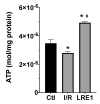The Soluble Adenylyl Cyclase Inhibitor LRE1 Prevents Hepatic Ischemia/Reperfusion Damage Through Improvement of Mitochondrial Function
- PMID: 32664470
- PMCID: PMC7402335
- DOI: 10.3390/ijms21144896
The Soluble Adenylyl Cyclase Inhibitor LRE1 Prevents Hepatic Ischemia/Reperfusion Damage Through Improvement of Mitochondrial Function
Abstract
Hepatic ischemia/reperfusion (I/R) injury is a leading cause of organ dysfunction and failure in numerous pathological and surgical settings. At the core of this issue lies mitochondrial dysfunction. Hence, strategies that prime mitochondria towards damage resilience might prove applicable in a clinical setting. A promising approach has been to induce a mitohormetic response, removing less capable organelles, and replacing them with more competent ones, in preparation for an insult. Recently, a soluble form of adenylyl cyclase (sAC) has been shown to exist within mitochondria, the activation of which improved mitochondrial function. Here, we sought to understand if inhibiting mitochondrial sAC would elicit mitohormesis and protect the liver from I/R injury. Wistar male rats were pretreated with LRE1, a specific sAC inhibitor, prior to the induction of hepatic I/R injury, after which mitochondria were collected and their metabolic function was assessed. We find LRE1 to be an effective inducer of a mitohormetic response based on all parameters tested, a phenomenon that appears to require the activity of the NAD+-dependent sirtuin deacylase (SirT3) and the subsequent deacetylation of mitochondrial proteins. We conclude that LRE1 pretreatment leads to a mitohormetic response that protects mitochondrial function during I/R injury.
Keywords: LRE1; ischemia/reperfusion; liver; mitochondria; sirtuin 3; soluble adenylyl cyclase.
Conflict of interest statement
D.A.S. is a consultant to, inventor of patents licensed to, and, in some cases, board member and investor of MetroBiotech, CohBar, Life Biosciences and affiliates, InsideTracker, Vium, Zymo, EdenRoc Sciences and affiliates, Immetas, Segterra, Galilei Biosciences, and Iduna Therapeutics. He is also an inventor on patent applications licensed to Bayer Crops, Merck KGaA, and Elysium Health. For details see
Figures








References
-
- Martins R.M., Pinto Rolo A., Soeiro Teodoro J., Furtado E., Caetano Oliveira R., Tralhão J.G., Marques Palmeira C. Addition of Berberine to Preservation Solution in an Animal Model of Ex Vivo Liver Transplant Preserves Mitochondrial Function and Bioenergetics from the Damage Induced by Ischemia/Reperfusion. Int. J. Mol. Sci. 2011;19:184–189. doi: 10.3390/ijms19010284. - DOI - PMC - PubMed
MeSH terms
Substances
Grants and funding
- HEALTHYAGING 2020 CENTRO-01-0145-FEDER-000012/Fundação para a Ciência e a Tecnologia
- R01 grant/NH/NIH HHS/United States
- POCI-01-0145-FEDER-016770/Fundação para a Ciência e a Tecnologia
- SFRH/BPD/94036/2013/Fundação para a Ciência e a Tecnologia
- CENTRO-01-0145-FEDER-000012-HealthyAging2020/European Regional Development Fund
LinkOut - more resources
Full Text Sources
Research Materials

